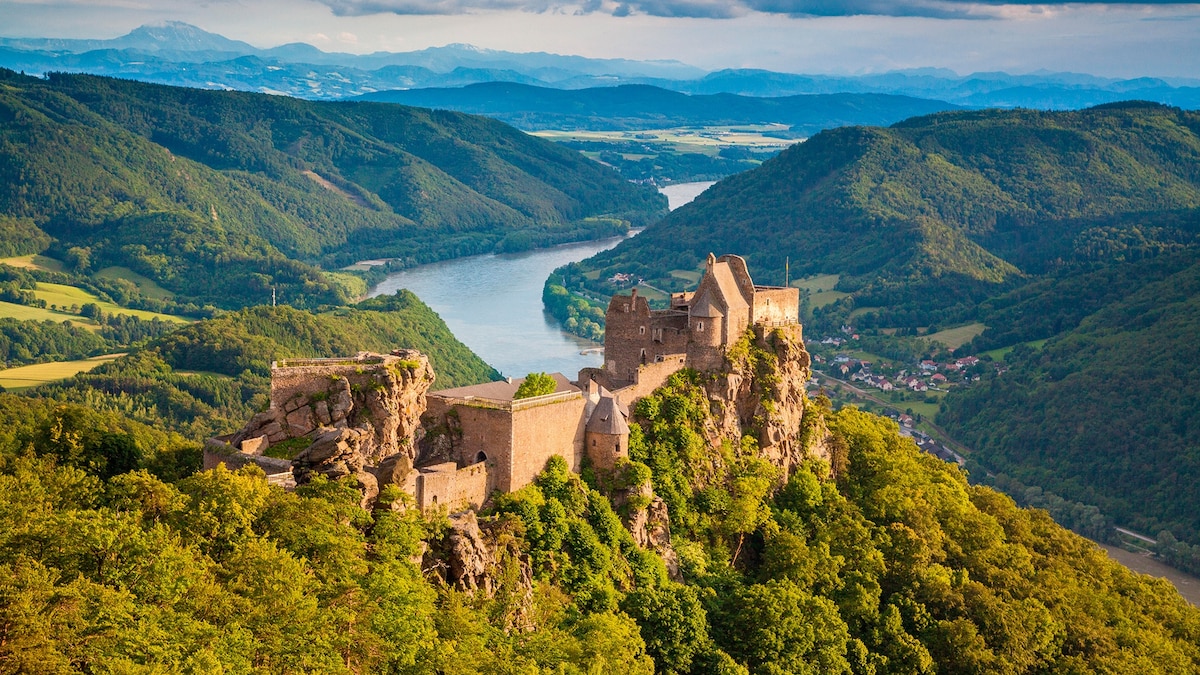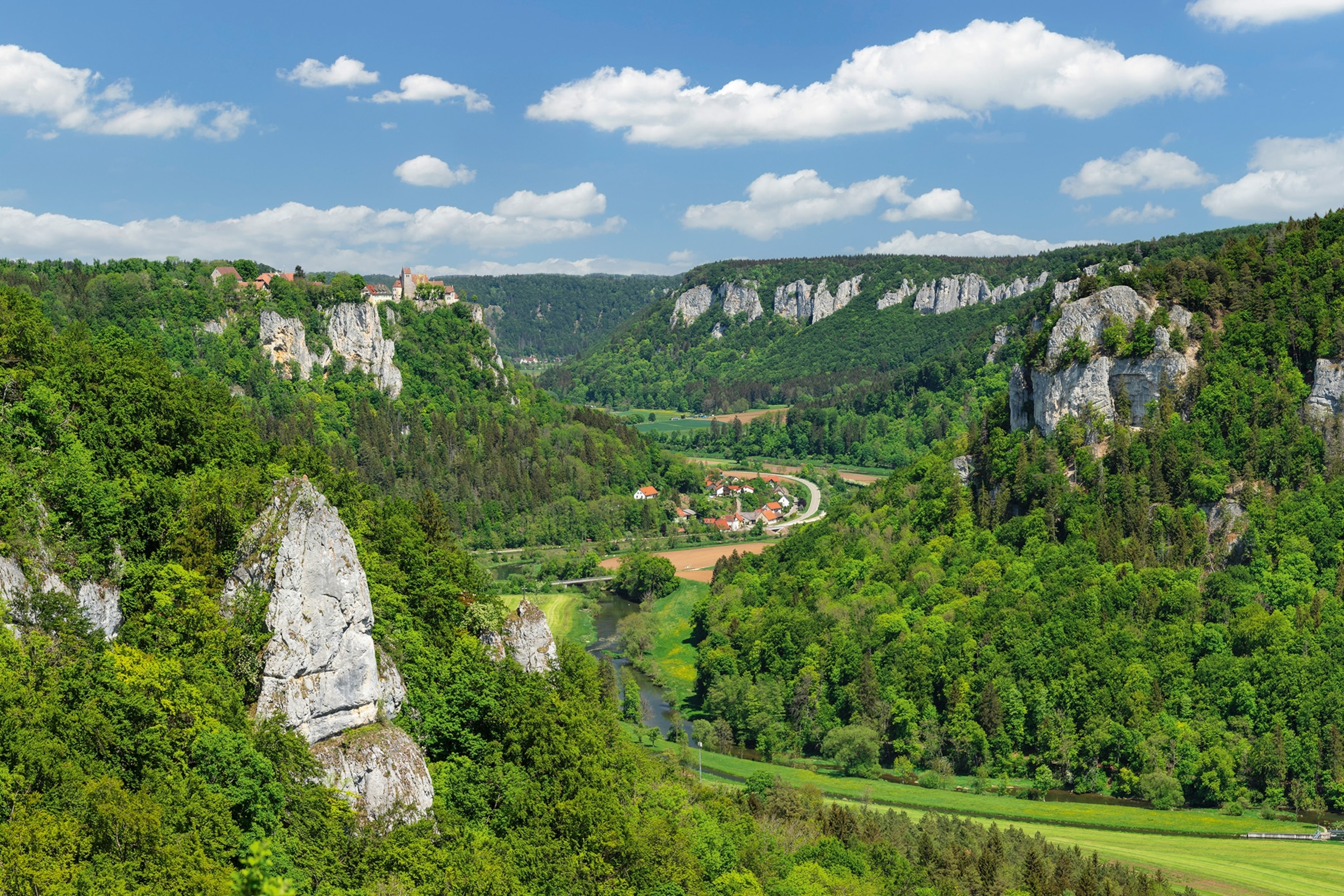Now Reading: How to plan the ultimate adventure along the Danube River
-
01
How to plan the ultimate adventure along the Danube River
How to plan the ultimate adventure along the Danube River

This article was produced by National Geographic Traveller (UK).
The Danube touches deep. Its landscapes are lyrical, its cities were built high and mighty by once-great empires, its history is as old as European civilisation itself. In 1866, Johann Strauss II extolled its beauty in The Blue Danube. And in 2025, on the 200th anniversary of the Austrian composer’s birth, his ever-popular waltz still captures the sprightly soul of the river, which flows from the Black Forest in Germany to the Black Sea in Romania and Ukraine. Whether seen in the mist of winter or summer’s first light, there’s poetry in these waters.
But where to begin? Many tours zoom in on the classic sights necklacing the Upper Danube between Germany and Hungary. The knockout is the 24-mile Wachau Valley in Upper Austria, a UNESCO World Heritage Site, where the river lopes past orchards and terraced vineyards, perched abbeys and medieval forts. It’s lovely, no doubt, as are the capitals that follow — Vienna, with its opulent Habsburg palaces, and Budapest, home to art nouveau thermal bathhouses. Cruises are a popular option, but if you want to explore independently, it’s also possible to hike along a network of well-developed trails, or pedal on the Danube Cycle Path, which rolls from the river’s source to its delta.
Venture east, and you’ll be rewarded with treasures fewer people experience. Croatia’s section of the river has wonders like Tvrđa, a star-shaped, 18th-century fortress, and Kopački Rit Nature Park, a floodplain where waterways meet, attracting birdlife from white-tailed eagles to black storks. In Serbia, the Danube flows past the cliff-hugging Golubac Fortress, the fjord-like Iron Gates gorge and Lepenski Vir, Europe’s oldest planned settlement.
All this is the drum roll for the moment when the river takes a final bow at the Danube Delta, a delicate fretwork of marshes, canals and islands. Your eyes will constantly flit between water and sky to spot pelicans, ibises and the brilliant blue flash of kingfishers.
Give yourself plenty of time, as you can’t hurry this river. The longer you stay and further you explore, the more its ever-changing moods, lights, flavours and backdrops will sweep you off your feet, with all the easy grace of Strauss’s famous waltz.
Itinerary 1: Danube Cycle Path
Start point: Passau
End point: Vienna
Distance travelled: 208 miles
Average duration: 10 days
The river reveals itself in all its glory in this gentle section of the Danube Cycle Path in the Upper Danube. The trail follows the riverbank through Germany and Austria, tracing each elegant bend through woods, farmland and flower-freckled meadows. You’ll find something to make you want to hop out of the saddle almost constantly — from giddy viewpoints to Trappist monasteries; from art galleries to some of Austria’s finest heurigen (rustic wine taverns serving citrusy, mineral Grüner Veltliner and Riesling whites).
The route is bookended by two grand cities. It starts in Passau, which has a baroque old town and was once the largest bishopric in the Holy Roman Empire. Vienna is a fitting climax, with its collection of grand palaces, galleries, concert halls and coffee houses. While the ride itself takes around a week, set aside 10 days to also explore these gateways at leisure.
There are many memorable moments along the way, but the Wachau Valley, which covers the second half of this itinerary, is particularly popular. Here, the Danube flows past medieval castles and baroque abbeys, vineyards and orchards. The latter are pinkened with blossom in spring, and heavy with apricots in summer.
The ride covers between 25 and 44 miles a day, equating to around three to four hours in the saddle, on mostly flat terrain. Take it at a gentle pace; this is a ride to relish, not rush.

The Danube Cycle Path is bookended by two grand cities, starting in Passau and ending in Vienna, with a grandiose selection of grand palaces, galleries, concert halls and coffee houses like Cafe Central in the Innere Stadt district.
Photograph by AWL Images; Jon Arnold
1. Schlögener loop
Found after crossing from Germany into Austria, this oxbow is hands-down one of the most photogenic stretches of the Danube Valley. It ramps up the scenic drama tenfold: here, the river forms a perfect 180-degree bend as it snakes through granite hills green with pine and oak. It’s impressive from the saddle, but for ringside views, hike half an hour up the slopes to the Schlögener Blick viewpoint. Back by the banks, cross the river by ferry to continue along the path.
2. Linz
In stark contrast to many of the quaint, baroque towns on this ride, this finger-on-the-pulse city propels you into the 21st century. Visit the Ars Electronica Center, which showcases new technology, science and digital media via interactive exhibitions, and the Lentos gallery, which homes in on contemporary art. Exhibitions often draw on the permanent collection, which harbours works by Austrian artists like Klimt, Kokoschka and Schiele.
3. Grein
Tucked into the folds of forested hills, this mellow little town reclines on a lovely sweep of the river. It’s topped by a baroque, turreted castle that looks like it’s been plucked from a children’s bedtime story; its arcaded inner courtyard, dating from the late Renaissance, is a beauty. The town hall houses an 18th-century theatre, Austria’s oldest still in operation. Performances are in German, but visitors can see the building on guided tours of the town.
4. Melk abbey
For many cyclists, the city of Melk is the ride’s cultural highlight. Perched sky-high on a hill above the river, its Benedictine Abbey lifts gazes and spirits with its vast, lemon-and-white-striped facade, twin spires and bauble dome. A visit whisks you around the baroque abbey church and lavishly frescoed Marble Hall, which served as a dining room for the imperial family and distinguished guests.

Visit the medieval ruined castle of Dürnstein, around half an hour from Dürnstein town, to enjoy the panoramic views of the Wachau Valley.
Photograph by Getty Images; Vladislav Zolotov
5. Dürnstein Castle
Set atop a rock and enveloped in greenery, the medieval ruined castle of Dürnstein is one of the most dashing in the Wachau Valley. Word has it that Richard the Lionheart was imprisoned here for a year in the late 12th century, after offending the Duke of Austria, Leopold V. From Dürnstein town, you can stomp to the castle in around half an hour, visit for free and enjoy the panoramic views.
6. Tulln
With pretty gardens, river beaches and vestiges of Roman rule, this town would merit a stop even if it weren’t for its claim to fame as the home of one of Austria’s most famous artists, expressionist Egon Schiele. Most visitors stop here to dive into its two dedicated museums — one set in the house where Schiele was born, the other showcasing his emotive art in a former jail near the Danube.
Itinerary 2: The Upper Danube Nature Park
Start point: Lemberg
End point: Beuron
Distance travelled: 35 miles
Average duration: Four days
Close to where the river springs up in Germany’s Black Forest, the Upper Danube Valley is the stuff of Romantic painter dreams, but it receives just a trickle of the visitors you’ll find further east. The best way to see it is by lacing up boots on the Donauberglandweg (‘Danube highland trail’), a moderately challenging, easy-to-navigate, four-day trek through Germany’s Swabian Jura mountain range. The Danube — still narrow this close to the source — is your near-constant companion as you head up karst peaks and across beautiful juniper heathland.
The itinerary starts on Lemberg mountain, near the town of Gosheim, and finishes in the village of Beuron, but with a week to spare it’s worth tacking on a couple of days to explore the bigger towns in the area. Tuttlingen, near Gosheim, on the banks of the Danube, is crowned by the ruins of 15th-century Burg Honberg fortress. Sigmaringen, to the east of Beuron, has red-roofed, gabled houses, topped off by a palace once owned by the powerful Hohenzollern dynasty.
You’ll do four-and-a-half to six hours of walking each day, passing numerous towns and villages. Bring binoculars for a chance of sighting chamois, eagle owls and falcons.
1. Lemberg
The trail begins on a literal high at Lemberg, the loftiest point in the Swabian Jura at 3,330ft. The Bära river, a tributary of the Danube, springs up at the foot of this densely wooded mountain. Traces of the Iron Age Hallstatt culture have been unearthed here, but it’s the view from the 12-floor, steel-lattice observation tower that’s the real draw. On cloud-free days, it reaches beyond the Black Forest to the German and Swiss Alps.
2. Dreifaltigkeitsberg
On the southwestern cusp of the Swabian Jura, this 3,231ft peak affords similarly arresting views. At the top, the powder-puff pink, onion-domed pilgrimage chapel is a baroque beauty. Visit the church, then go for a drink in the tavern’s beer garden, whose terrace overlooks a patchwork quilt of meadow, fell and forest.
3. Alter Berg, Böttingen
Rising above the town of Böttingen, 3,215ft Alter Berg is dubbed the ‘Old Mountain’ with good reason — the Celts were already here over 6,000 years ago. The landscape feels suitably ancient, with juniper heaths, gold grasslands, stone ridges, forests and hedges. A Way of the Cross (short trails featuring images from Jesus’s crucifixion) leads to the top.

The best way to see the Upper Danube Valley is by lacing up boots on the Donauberglandweg (‘Danube highland trail’), a moderately challenging, easy-to-navigate, four-day trek through Germany’s Swabian Jura mountain range.
Photograph by AWL Images; Markus Lange
4. Mühlheim an der Donau
Hugging the banks of the Danube, this town, with its gate towers, cobbles and gables, seems plucked from a Grimm fairytale. It grew in prominence in the Middle Ages, when it came under the thumb of the royal Hohenzollern family. Its biggest attention-grabber is its castle, built in around 1200 for the Lords of Enzberg and reconstructed in the 18th century, crowned by two baroque onion domes.
5. Fridingen
The Upper Danube Valley feels especially adventurous around this town. The trail heads up and down rocky ridges to eyrie-like lookouts atop limestone crags — honeycombed with caves — that tumble down to the grey-green river. Head to the viewpoints of Laibfelsen and Stiegelesfels, and stop off at the riverside Ziegelhütte Fridingen, a self-service snack bar and beer garden, for a drink.
6. Beuron
The hike ends on a cultural high in Beuron. Your gaze will be drawn to the vast facade of its massive working Benedictine abbey, which is among Germany’s oldest (its monastic origins date to 1077). While the abbey is off limits, the ornate baroque church — a riot of stucco, marble and frescoes — is well worth a visit. beuron.de
Published in the April 2025 issue of National Geographic Traveller (UK).
To subscribe to National Geographic Traveller (UK) magazine click here. (Available in select countries only).























